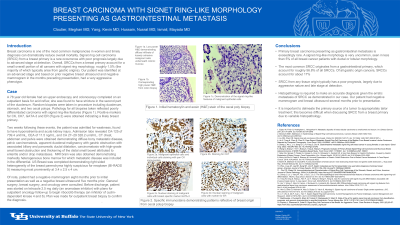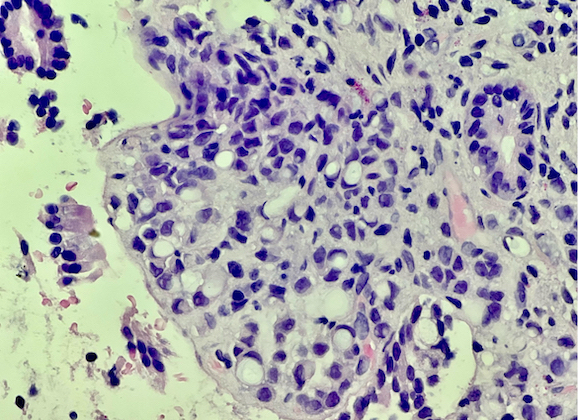Tuesday Poster Session
Category: Stomach
P5069 - Breast Carcinoma With Signet Ring-Like Morphology Presenting as Gastrointestinal Metastasis
Tuesday, October 29, 2024
10:30 AM - 4:00 PM ET
Location: Exhibit Hall E

Has Audio

Meghan Cloutier, MD
University at Buffalo
Buffalo, NY
Presenting Author(s)
Meghan Cloutier, MD, Kevin Yang, MD, Mayada Ismail, MD, Nusrat Hussain, MD
University at Buffalo, Buffalo, NY
Introduction: Breast carcinoma is one of the most common malignancies in women and timely diagnosis can reduce overall mortality. However, signet ring cell carcinoma (SRCC) from a breast primary is a rare and incompletely defined occurrence with poor prognosis largely due to advanced stage at detection. Breast primaries account for a small portion of all SRCCs- the majority arise from gastric origins. Regardless of origin SRCCs are aggressive and metastasize widely- typically to bone, stomach, lung, and liver. Our patient was identified with SRCC from a breast primary at an advanced stage with unusual presentation in the GI tract.
Case Description/Methods: A 78 year old female without significant history presents for upper endoscopy and colonoscopy to investigate acid reflux. Random biopsies were taken including duodenum, stomach, and two cecal polyps. Pathology for all reflected poorly differentiated carcinoma with signet ring-like features. Positive markers for CK, CK7, GATA-3 and ER were obtained indicating a likely breast primary. Two weeks following, the patient was admitted due to weakness. Labs revealed elevated CA-125, CEA and CA 27–29. CT chest, abdomen and pelvis showed metastasis including pelvic carcinomatosis, apparent duodenal malignancy with gastric obstruction, and associated biliary ductal dilatation. MRI brain demonstrated heterogeneous bone marrow suspicious for metastasis. US Breast demonstrated lesion of the right breast measuring most prominently 3.4 x 2.5 x 4 cm. Of note, patient had a negative mammogram and breast ultrasound eight and five months prior, respectively. General surgery, breast surgery, and oncology were consulted. Plan was made for breast biopsy to confirm the diagnosis. Despite presenting based on gastrointestinal biopsies, the diagnosis of SRCC from a breast primary was made.
Discussion: Gastrointestinal metastasis from a breast primary is rare and is exceedingly rare when the primary is unknown. Literature revealed few similar cases, and when metastasis occurs patients had known cancer or at minimum a palpable breast mass. This makes our presentation extremely rare and is made even more impressive as the patient had negative mammogram and bilateral breast ultrasound less than one year prior. Histopathology is required to make a diagnosis given the erratic metastasis of SRCC as demonstrated. Overall prognosis in these cases is poor due to advanced stage on presentation. Regardless, it is important to delineate the primary source of a tumor to tailor treatment options.

Disclosures:
Meghan Cloutier, MD, Kevin Yang, MD, Mayada Ismail, MD, Nusrat Hussain, MD. P5069 - Breast Carcinoma With Signet Ring-Like Morphology Presenting as Gastrointestinal Metastasis, ACG 2024 Annual Scientific Meeting Abstracts. Philadelphia, PA: American College of Gastroenterology.
University at Buffalo, Buffalo, NY
Introduction: Breast carcinoma is one of the most common malignancies in women and timely diagnosis can reduce overall mortality. However, signet ring cell carcinoma (SRCC) from a breast primary is a rare and incompletely defined occurrence with poor prognosis largely due to advanced stage at detection. Breast primaries account for a small portion of all SRCCs- the majority arise from gastric origins. Regardless of origin SRCCs are aggressive and metastasize widely- typically to bone, stomach, lung, and liver. Our patient was identified with SRCC from a breast primary at an advanced stage with unusual presentation in the GI tract.
Case Description/Methods: A 78 year old female without significant history presents for upper endoscopy and colonoscopy to investigate acid reflux. Random biopsies were taken including duodenum, stomach, and two cecal polyps. Pathology for all reflected poorly differentiated carcinoma with signet ring-like features. Positive markers for CK, CK7, GATA-3 and ER were obtained indicating a likely breast primary. Two weeks following, the patient was admitted due to weakness. Labs revealed elevated CA-125, CEA and CA 27–29. CT chest, abdomen and pelvis showed metastasis including pelvic carcinomatosis, apparent duodenal malignancy with gastric obstruction, and associated biliary ductal dilatation. MRI brain demonstrated heterogeneous bone marrow suspicious for metastasis. US Breast demonstrated lesion of the right breast measuring most prominently 3.4 x 2.5 x 4 cm. Of note, patient had a negative mammogram and breast ultrasound eight and five months prior, respectively. General surgery, breast surgery, and oncology were consulted. Plan was made for breast biopsy to confirm the diagnosis. Despite presenting based on gastrointestinal biopsies, the diagnosis of SRCC from a breast primary was made.
Discussion: Gastrointestinal metastasis from a breast primary is rare and is exceedingly rare when the primary is unknown. Literature revealed few similar cases, and when metastasis occurs patients had known cancer or at minimum a palpable breast mass. This makes our presentation extremely rare and is made even more impressive as the patient had negative mammogram and bilateral breast ultrasound less than one year prior. Histopathology is required to make a diagnosis given the erratic metastasis of SRCC as demonstrated. Overall prognosis in these cases is poor due to advanced stage on presentation. Regardless, it is important to delineate the primary source of a tumor to tailor treatment options.

Figure: Demonstration of the signet ring-like features of malignant epithelial cells from colon biopsy
Disclosures:
Meghan Cloutier indicated no relevant financial relationships.
Kevin Yang indicated no relevant financial relationships.
Mayada Ismail indicated no relevant financial relationships.
Nusrat Hussain indicated no relevant financial relationships.
Meghan Cloutier, MD, Kevin Yang, MD, Mayada Ismail, MD, Nusrat Hussain, MD. P5069 - Breast Carcinoma With Signet Ring-Like Morphology Presenting as Gastrointestinal Metastasis, ACG 2024 Annual Scientific Meeting Abstracts. Philadelphia, PA: American College of Gastroenterology.
